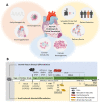Cardiac Cell Therapy with Pluripotent Stem Cell-Derived Cardiomyocytes: What Has Been Done and What Remains to Do?
- PMID: 35275365
- PMCID: PMC9068652
- DOI: 10.1007/s11886-022-01666-9
Cardiac Cell Therapy with Pluripotent Stem Cell-Derived Cardiomyocytes: What Has Been Done and What Remains to Do?
Abstract
Purpose of review: Exciting pre-clinical data presents pluripotent stem cell-derived cardiomyocytes (PSC-CM) as a novel therapeutic prospect following myocardial infarction, and worldwide clinical trials are imminent. However, despite notable advances, several challenges remain. Here, we review PSC-CM pre-clinical studies, identifying key translational hurdles. We further discuss cell production and characterization strategies, identifying markers that may help generate cells which overcome these barriers.
Recent findings: PSC-CMs can robustly repopulate infarcted myocardium with functional, force generating cardiomyocytes. However, current differentiation protocols produce immature and heterogenous cardiomyocytes, creating related issues such as arrhythmogenicity, immunogenicity and poor engraftment. Recent efforts have enhanced our understanding of cardiovascular developmental biology. This knowledge may help implement novel differentiation or gene editing strategies that could overcome these limitations. PSC-CMs are an exciting therapeutic prospect. Despite substantial recent advances, limitations of the technology remain. However, with our continued and increasing biological understanding, these issues are addressable, with several worldwide clinical trials anticipated in the coming years.
Keywords: Cardiac cell therapy; Cardiomyocytes; Embryonic stems cells; Heart regeneration; Induced pluripotent stem cells; Stem cells.
© 2022. The Author(s).
Conflict of interest statement
The authors declare no competing interests.
Figures

References
Publication types
MeSH terms
LinkOut - more resources
Full Text Sources
Other Literature Sources
Research Materials

